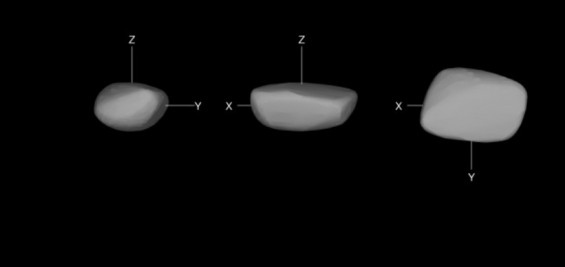
A three-dimensional (3D) shape model of the asteroid ‘2012 TC4’. This is the first time it has been confirmed that the austerity is 15m and the short axis is 8m. Provided by Korea Astronomical Research Institute
It has been confirmed for the first time that the rotation speed of the asteroid ‘2012 TC4’, which has passed through the Earth twice in the past 10 years, is accelerating. Changes in rotation speed can affect the asteroid’s orbit in the future, which is important for predicting the risk of asteroid impacting Earth.
The Korea Astronomical Research Institute announced on the 18th that it has confirmed this content in collaboration with the Czech Republic’s Karel University and published it in the online edition of the February 11th’Astronomical Journal’ published by the American Astronomical Society.
The 2012 TC4 passed about 95,000 kilometers from Earth in 2012. In 2017, it entered the moon’s orbit closer than this and was tense while passing an altitude of about 50,000 km, a point outside the altitude of 36,000 km where geostationary orbit satellites were concentrated.
Until now, only the degree to which the 2012 TC4 has a non-maintenance rotation has been known. Non-main axis rotational motion refers to a phenomenon in which precession and rotation occur at the same time as if the top twists and rotates before falling.
Cheonmunyeon led a campaign to track changes in the brightness of the asteroid and collected observational data from 21 astronomical observatories around the world. As a result, it was confirmed that between 2012 and 2017, the rotation speed of the asteroid increased by 18 seconds. It was also found that this was due to the’Yov effect’ that occurs when asteroids absorb and re-emit solar energy.
The first author of the paper, Lee Hee-jae, a postdoctoral researcher at the Korea Astronomical Research Institute, said, “The asteroid rotates rapidly with a rotation period of 27.8 minutes and a precession period of 8.5 minutes.” I checked it for the first time.”
This study is expected to be helpful for the exploration of the asteroid Apopis, which is being promoted by Cheonmunyeon. Apophis is expected to pass through a 31,000km point very close to Earth on April 14, 2029, and Cheon Mun-yeon is pushing ahead with a plan to send a probe to Apophis in time for this time.
Postdoctoral researcher Lee said, “In the case of Apophis, it is known that the probability of a collision with the Earth has increased recently due to the Yope effect.” In order to increase the success rate of the exploration, we plan to further investigate the rotational cycle and shape of Apophis based on this experience of observing asteroids. I said.
